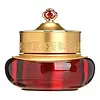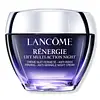What's inside
What's inside
 Key Ingredients
Key Ingredients

 Benefits
Benefits

 Concerns
Concerns

 Ingredients Side-by-side
Ingredients Side-by-side

Water
Skin ConditioningDipropylene Glycol
HumectantCyclopentasiloxane
EmollientMethyl Trimethicone
Skin ConditioningGlycerin
HumectantDimethicone
EmollientCetearyl Alcohol
EmollientPCA Dimethicone
Skin ConditioningGlyceryl Stearate
EmollientPanax Ginseng Root Extract
Emollient1,2-Hexanediol
Skin ConditioningPanthenol
Skin ConditioningPoncirus Trifoliata Fruit Extract
Skin ConditioningPEG-100 Stearate
Cetearyl Olivate
Dimethiconol
EmollientSorbitan Olivate
EmulsifyingPEG-150 Distearate
EmulsifyingC14-22 Alcohols
Emulsion StabilisingSqualane
EmollientAngelica Acutiloba Root Extract
Skin ConditioningAsparagus Cochinchinensis Root Extract
Skin ConditioningPolygonatum Officinale Rhizome/Root Extract
Skin ConditioningAcanthopanax Senticosus Root Extract
Skin ConditioningPolygonum Multiflorum Root Extract
Skin ConditioningAmmonium Acryloyldimethyltaurate/Vp Copolymer
Punica Granatum Fruit Extract
AntioxidantCimicifuga Racemosa Root Extract
AntimicrobialDioscorea Japonica Root Extract
Skin ConditioningLithospermum Erythrorhizon Root Extract
Skin ConditioningTrifolium Pratense Leaf Extract
AntioxidantZiziphus Jujuba Fruit Extract
Skin ConditioningAtractylodes Japonica Rhizome Extract
Skin ConditioningCornus Officinalis Fruit Extract
Skin ConditioningGlycyrrhiza Glabra Root Extract
BleachingPaeonia Albiflora Root Extract
Skin ConditioningPaeonia Suffruticosa Root Extract
Skin ProtectingPlantago Asiatica Extract
Skin ConditioningPrunus Persica Kernel Extract
MoisturisingScutellaria Baicalensis Root Extract
AstringentThymus Vulgaris Extract
PerfumingVelvet Extract
HumectantMacadamia Ternifolia Seed Oil
EmollientTriethylhexanoin
MaskingPortulaca Oleracea Extract
Skin ConditioningStearyl Glycyrrhetinate
Skin ConditioningTheobroma Cacao Extract
Skin ConditioningXanthan Gum
EmulsifyingArachidyl Glucoside
EmulsifyingButyrospermum Parkii Butter
Skin ConditioningHydrogenated Lecithin
EmulsifyingTrisodium EDTA
Stearic Acid
CleansingCarbomer
Emulsion StabilisingCeramide NP
Skin ConditioningCholesterol
EmollientTromethamine
BufferingGinsenosides
Skin ConditioningSaccharomyces/Xylinum/Black Tea Ferment
Skin ConditioningParfum
MaskingWater, Dipropylene Glycol, Cyclopentasiloxane, Methyl Trimethicone, Glycerin, Dimethicone, Cetearyl Alcohol, PCA Dimethicone, Glyceryl Stearate, Panax Ginseng Root Extract, 1,2-Hexanediol, Panthenol, Poncirus Trifoliata Fruit Extract, PEG-100 Stearate, Cetearyl Olivate, Dimethiconol, Sorbitan Olivate, PEG-150 Distearate, C14-22 Alcohols, Squalane, Angelica Acutiloba Root Extract, Asparagus Cochinchinensis Root Extract, Polygonatum Officinale Rhizome/Root Extract, Acanthopanax Senticosus Root Extract, Polygonum Multiflorum Root Extract, Ammonium Acryloyldimethyltaurate/Vp Copolymer, Punica Granatum Fruit Extract, Cimicifuga Racemosa Root Extract, Dioscorea Japonica Root Extract, Lithospermum Erythrorhizon Root Extract, Trifolium Pratense Leaf Extract, Ziziphus Jujuba Fruit Extract, Atractylodes Japonica Rhizome Extract, Cornus Officinalis Fruit Extract, Glycyrrhiza Glabra Root Extract, Paeonia Albiflora Root Extract, Paeonia Suffruticosa Root Extract, Plantago Asiatica Extract, Prunus Persica Kernel Extract, Scutellaria Baicalensis Root Extract, Thymus Vulgaris Extract, Velvet Extract, Macadamia Ternifolia Seed Oil, Triethylhexanoin, Portulaca Oleracea Extract, Stearyl Glycyrrhetinate, Theobroma Cacao Extract, Xanthan Gum, Arachidyl Glucoside, Butyrospermum Parkii Butter, Hydrogenated Lecithin, Trisodium EDTA, Stearic Acid, Carbomer, Ceramide NP, Cholesterol, Tromethamine, Ginsenosides, Saccharomyces/Xylinum/Black Tea Ferment, Parfum
Water
Skin ConditioningGlycerin
HumectantPrunus Armeniaca Kernel Oil
MaskingCaprylic/Capric Triglyceride
MaskingPentaerythrityl Tetraethylhexanoate
EmollientCetyl Alcohol
EmollientZea Mays Starch
AbsorbentButyrospermum Parkii Butter
Skin ConditioningAlcohol Denat.
AntimicrobialPetrolatum
EmollientPentylene Glycol
Skin ConditioningGlyceryl Stearate
EmollientDimethicone
EmollientPEG-40 Stearate
EmulsifyingCera Alba
EmollientHydroxyethylpiperazine Ethane Sulfonic Acid
BufferingCI 14700
Cosmetic ColorantCI 19140
Cosmetic ColorantSaccharomyces/Xylinum/Black Tea Ferment
Skin ConditioningHydrolyzed Linseed Extract
Skin ConditioningHydrolyzed Soy Protein
HumectantHydrolyzed Hyaluronic Acid
HumectantSodium Hydroxide
BufferingSodium Benzoate
MaskingPhenoxyethanol
PreservativeAdenosine
Skin ConditioningStearyl Alcohol
EmollientAcetyl Tetrapeptide-9
Skin ConditioningPoloxamer 338
EmulsifyingDimethiconol
EmollientLimonene
PerfumingXanthan Gum
EmulsifyingPentaerythrityl Tetra-Di-T-Butyl Hydroxyhydrocinnamate
AntioxidantBenzyl Alcohol
PerfumingCaprylyl Glycol
EmollientAlpha-Isomethyl Ionone
PerfumingSorbitan Tristearate
EmulsifyingMyristyl Alcohol
EmollientGeraniol
PerfumingHexyl Cinnamal
PerfumingParfum
MaskingWater, Glycerin, Prunus Armeniaca Kernel Oil, Caprylic/Capric Triglyceride, Pentaerythrityl Tetraethylhexanoate, Cetyl Alcohol, Zea Mays Starch, Butyrospermum Parkii Butter, Alcohol Denat., Petrolatum, Pentylene Glycol, Glyceryl Stearate, Dimethicone, PEG-40 Stearate, Cera Alba, Hydroxyethylpiperazine Ethane Sulfonic Acid, CI 14700, CI 19140, Saccharomyces/Xylinum/Black Tea Ferment, Hydrolyzed Linseed Extract, Hydrolyzed Soy Protein, Hydrolyzed Hyaluronic Acid, Sodium Hydroxide, Sodium Benzoate, Phenoxyethanol, Adenosine, Stearyl Alcohol, Acetyl Tetrapeptide-9, Poloxamer 338, Dimethiconol, Limonene, Xanthan Gum, Pentaerythrityl Tetra-Di-T-Butyl Hydroxyhydrocinnamate, Benzyl Alcohol, Caprylyl Glycol, Alpha-Isomethyl Ionone, Sorbitan Tristearate, Myristyl Alcohol, Geraniol, Hexyl Cinnamal, Parfum
Ingredients Explained
These ingredients are found in both products.
Ingredients higher up in an ingredient list are typically present in a larger amount.
This ingredient is also known as shea butter. It is an effective skin hydrator and emollient.
Emollients help soothe and soften your skin. It does this by creating a protective film on your skin. This barrier helps trap moisture and keeps your skin hydrated. Emollients may be effective at treating dry or itchy skin.
Shea butter is rich in antioxidants. Antioxidants help fight free-radicals, or molecules that may harm the body. It is also full of fatty acids including stearic acid and linoleic acid. These acids help replenish the skin and keep skin moisturized.
While Shea Butter has an SPF rating of about 3-4, it is not a sunscreen replacement.
Shea butter may not be fungal acne safe. We recommend speaking with a professional if you have any concerns.
Learn more about Butyrospermum Parkii ButterDimethicone is a type of synthetic silicone created from natural materials such as quartz.
What it does:
Dimethicone comes in different viscosities:
Depending on the viscosity, dimethicone has different properties.
Ingredients lists don't always show which type is used, so we recommend reaching out to the brand if you have questions about the viscosity.
This ingredient is unlikely to cause irritation because it does not get absorbed into skin. However, people with silicone allergies should be careful about using this ingredient.
Note: Dimethicone may contribute to pilling. This is because it is not oil or water soluble, so pilling may occur when layered with products. When mixed with heavy oils in a formula, the outcome is also quite greasy.
Learn more about DimethiconeDimethiconol is a silicone that resembles the popular dimethicone. Like other silicones, it is an emollient. Emollients create a thin film on skin to prevent moisture from escaping.
This ingredient helps to create a silky texture and improve spreadability. Due to its high molecular weight and thickness, it is often combined with cyclopentasiloxane.
Glycerin is already naturally found in your skin. It helps moisturize and protect your skin.
A study from 2016 found glycerin to be more effective as a humectant than AHAs and hyaluronic acid.
As a humectant, it helps the skin stay hydrated by pulling moisture to your skin. The low molecular weight of glycerin allows it to pull moisture into the deeper layers of your skin.
Hydrated skin improves your skin barrier; Your skin barrier helps protect against irritants and bacteria.
Glycerin has also been found to have antimicrobial and antiviral properties. Due to these properties, glycerin is often used in wound and burn treatments.
In cosmetics, glycerin is usually derived from plants such as soybean or palm. However, it can also be sourced from animals, such as tallow or animal fat.
This ingredient is organic, colorless, odorless, and non-toxic.
Glycerin is the name for this ingredient in American English. British English uses Glycerol/Glycerine.
Learn more about GlycerinGlyceryl Stearate is a mix of glycerin and stearic acid.
It is used to stabilize the mixing of water and oil ingredients. By preventing these ingredients from separating, it can help elongate shelf life. It can also help thicken the product's texture.
As an emollient, it helps soften skin and supports barrier-replenishing ingredients.
In cosmetics, Glyceryl Stearate is often made from vegetable oils or synthetically produced.
This ingredient may not be fungal-acne safe
Fun fact: The human body also creates Glyceryl Stearate naturally.
Learn more about Glyceryl StearateParfum is a catch-all term for an ingredient or more that is used to give a scent to products.
Also called "fragrance", this ingredient can be a blend of hundreds of chemicals or plant oils. This means every product with "fragrance" or "parfum" in the ingredients list is a different mixture.
For instance, Habanolide is a proprietary trade name for a specific aroma chemical. When used as a fragrance ingredient in cosmetics, most aroma chemicals fall under the broad labeling category of “FRAGRANCE” or “PARFUM” according to EU and US regulations.
The term 'parfum' or 'fragrance' is not regulated in many countries. In many cases, it is up to the brand to define this term.
For instance, many brands choose to label themselves as "fragrance-free" because they are not using synthetic fragrances. However, their products may still contain ingredients such as essential oils that are considered a fragrance by INCI standards.
One example is Calendula flower extract. Calendula is an essential oil that still imparts a scent or 'fragrance'.
Depending on the blend, the ingredients in the mixture can cause allergies and sensitivities on the skin. Some ingredients that are known EU allergens include linalool and citronellol.
Parfum can also be used to mask or cover an unpleasant scent.
The bottom line is: not all fragrances/parfum/ingredients are created equally. If you are worried about fragrances, we recommend taking a closer look at an ingredient. And of course, we always recommend speaking with a professional.
Learn more about ParfumThis combination of bacteria + black tea + fermentation = kombucha.
According to a manufacturer, this ingredient helps boost radiance, smoothness, and thickens skin.
You can read about the skin benefits of the individual parts here:
Saccharomyces
Black tea
Water. It's the most common cosmetic ingredient of all. You'll usually see it at the top of ingredient lists, meaning that it makes up the largest part of the product.
So why is it so popular? Water most often acts as a solvent - this means that it helps dissolve other ingredients into the formulation.
You'll also recognize water as that liquid we all need to stay alive. If you see this, drink a glass of water. Stay hydrated!
Learn more about WaterXanthan gum is used as a stabilizer and thickener within cosmetic products. It helps give products a sticky, thick feeling - preventing them from being too runny.
On the technical side of things, xanthan gum is a polysaccharide - a combination consisting of multiple sugar molecules bonded together.
Xanthan gum is a pretty common and great ingredient. It is a natural, non-toxic, non-irritating ingredient that is also commonly used in food products.
Learn more about Xanthan Gum